22 - Convection - Correlations for Heat Transfer Coefficient
Completion requirements
5. Thermal Boundary Layer

Thermal Entry Length: for laminar flow, \[\left(\frac{L}{D}\right)_{e,t} \approx 0.05\; \text{Re}\; \text{Pr}\]

Comparing thermal boundary layer with hydrodynamic boundary layer, it can be said that if \(\text{Pr}>1\), hydrodynamic boundary layer grows more rapidly. \[\text{Pr} > 1, \quad L_{e,h} < L_{e,t} \qquad \Longrightarrow \quad \delta > \delta_T \ \text{ at any section}\] Inverse is true for \(\text{Pr}<1\).
It is significant that the Prandtl number for most gases are sufficiently close to unity, and the hydrodynamic and thermal boundaries are of similar extent.
When \(\text{Pr}>1\), \(\delta>\delta_t\), and when \(\text{Pr}<1\), \(\delta<\delta_t\). High viscosity leads to a thick momentum boundary layer, and high thermal diffusivity leads to a thick thermal boundary layer.
